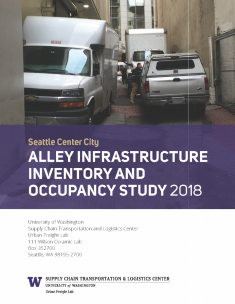Seattle is widely thought to be the first city in the U.S. and the E.U. to comprehensively map the Center City area's commercial vehicle load/unload space network, including its alleys. The data methods in this toolkit were designed and used to create a complete GIS database of the 417 alleys in Seattle's Center City area, mapping the alley network's geospatial location and documenting physical (truck-related) attributes measurements of alleys' key. These attributes directly impact alley operations and functionality.
SDOT and the research team purposefully chose which truck-related features to include in the alley inventory after consulting with both UFL members who deliver goods (such as UPS and USPS) and with other city agencies (such as police, fire, and public utilities) that regularly use alleys. For security purposes, the police need to know where alley entrances to buildings are located; the fire department must navigate large trucks through alleys; and utility infrastructure is frequently located in alleys.
As cities grow denser and more congested, the mix of competing alley users grows. Traditional box and parcel delivery trucks, vans and service vans who use alleys as the back door to buildings jockey for space with ride-share services like Lyft and Uber and passenger cars queuing in alleys to use off-street garages. Reports of conflicts and concerns about potential future conflicts (should alleys be inadequately managed to meet demand) are on the rise. To mitigate congestion, many cities face a growing need to actively manage their load/unload network. An alley survey is a key part of this process, helping policymakers and transportation officials understand how alley features impact the way a city's alley system works at street level.

